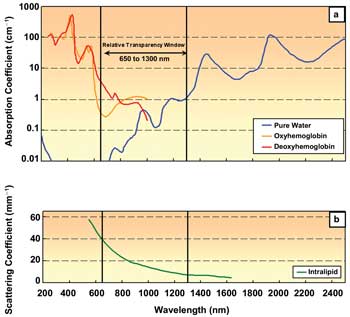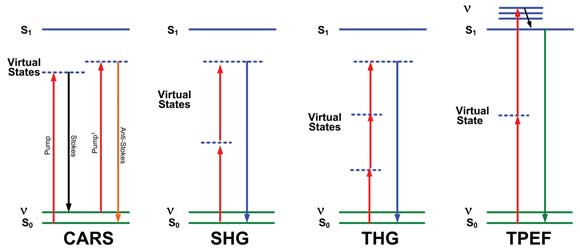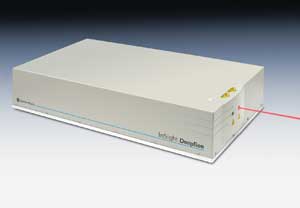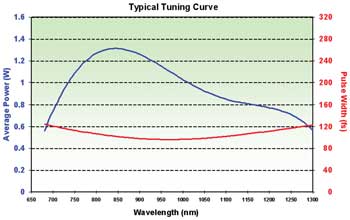Dr. Philip G. Smith and Julien Klein, !%Newport Corp.%!
New laser platforms developed to support the latest needs of biological imaging are poised to fuel the next wave of innovation in multiphoton microscopy: imaging deeper into tissue.
Two-photon excited fluorescence (TPEF) microscopy has seen rapid growth in the past two decades, fueled by substantial advances in the supporting laser technology.
TPEF microscopy was developed for live-cell imaging and uses femtosecond laser pulses for two-photon excitation of fluorophores. This excitation occurs only within a tight focal volume, where the laser’s photon density is high enough to cause two-photon absorption, eliminating out-of-focus excitation and providing inherent spatial sectioning. Because each fluorophore has a distinct two-photon excitation profile, wavelength-tunable femtosecond laser systems provide the flexibility to selectively excite the fluorophore of interest.
Recently, considerable efforts have been made to extend the depth of penetration into living tissue using longer infrared wavelengths. Another key trend has been the development of additional multimodal imaging techniques that complement TPEF microscopy. These trends have revealed the limits of current laser technology in terms of complexity, cost and ease of use. In response, commercial laser companies have developed new, innovative laser sources.
New solutions include platforms offering an increased tuning range compared with existing laser sources and an innovative approach to multimodal imaging.
In vivo microscopy
Since the original report on TPEF imaging in 1991,1 most researchers have preferred one-box, automated femtosecond Ti:sapphire oscillators as the source of excitation.2 For this reason, excitation wavelengths generally have been limited to the Ti:sapphire emission spectrum (roughly 700 to 1000 nm).
Recently, there has been considerable interest in the use of longer excitation wavelengths in the infrared region,3 typically between 1000 and 1300 nm. Various fluorophores optimized for use with long infrared wavelengths (e.g., Alexa 680, Cyanine 5.5) and fluorescent proteins (e.g., mCherry, mKate, mPlum and TagRFP-T) have been developed and are readily available today. There is a window of relatively low light absorption by tissue in vivo between 650 and 1300 nm (Figure 1a).4,5 More importantly, light scattering decreases with wavelength, allowing the ballistic photons for fluorescence excitation to penetrate deeper into turbid media such as tissue6 (Figure 1b). This reduced scatter makes the long-wavelength range of the relative transparency window particularly interesting for deep-tissue in vivo imaging.

Figure 1. (a) Absorption spectra of various components of biological material illustrate the relative transparency window in the near-infrared region. (b) Scattering profile of a 20 percent Intralipid sample (adapted from Chen et al) exhibits the classic 1/λ4 dependence of Rayleigh scattering.
Researchers have explored these benefits, mainly using Ti:sapphire laser-pumped optical parametric oscillator (OPO) systems. For instance, scientists at Cornell University in Ithaca, N.Y., recently showed that using a longer excitation wavelength at 1280 nm enables TPEF imaging of the cortical vasculature in mouse brains down to a depth of about 1.5 mm, compared with an imaging depth of about 0.6 mm at an excitation wavelength of 775 nm.3,7 Because the cerebral cortex in most mammals extends beyond 1 mm, deeper penetration becomes essential to fully examine its properties and dynamics in vivo.
Until today, the generation of these longer infrared wavelengths beyond 1 µm in a user-friendly and dependable way has remained a considerable challenge. In particular, the added cost and complexity of Ti:sapphire-pumped OPOs have limited their widespread use. The transmission of long infrared wavelengths through conventional multiphoton microscope systems has been limited as well.
However, this situation has changed recently as key optical components such as acousto-optic modulators and objectives specifically optimized for long wavelengths have become available.

Figure 2. Energy diagrams for selected multiphoton microscopy modalities: coherent anti-Stokes Raman scattering (CARS), second-harmonic generation (SHG), third-harmonic generation and two-photon excited fluorescence (TPEF).
Multimodal imaging
Another key trend in biological imaging has been to combine various imaging modalities in a single setup to obtain additional information about biological samples.8 Today, a femtosecond laser-based multiphoton imaging system can be used as follows (see Figure 2):
• Two- and three-photon excited fluorescence microscopy to image structures and indicators labeled with fluorescent proteins and dyes, and autofluorescence from intrinsic fluorophores such as elastin.
• Second-harmonic generation imaging to visualize biological structures of spatially ordered, inversion-asymmetric molecules, such as collagen fibers.
• Third-harmonic generation (THG) imaging to view interfaces in cells and tissues, such as cell membranes.
Additionally, if the same femtosecond laser system includes a second pulse train that is synchronized in time with the wavelength-tunable pulse train, it can be used for femtosecond coherent anti-Stokes Raman scattering (CARS) microscopy, a label-free technique that detects molecules based on their chemical composition. It has been widely used to image the lipid distribution within biological samples.9,10
By combining all these techniques, researchers can produce multimodal images that provide a wealth of complementary information from the same microscopy setup, maximizing its research capabilities and scientific reach.
The signal strength in multiphoton applications increases with decreasing pulse width. To fully realize the benefits of femtosecond laser pulses, their short pulse width must be maintained at the location of the biological specimen. When femtosecond laser pulses travel through a considerable amount of optical material, as is the case in most commercial confocal microscopes, they are broadened in time due to optical dispersion. To counteract this effect, it is possible to precompensate for this broadening by introducing negative group velocity dispersion (GVD) into the beam path to the sample. This negative GVD allows maintaining the short pulses from the laser at the location of the focus within the sample, a necessary condition to maximize depth penetration and optimize image contrast and brightness.
While the technique of dispersion compensation has been known since the initial development of femtosecond lasers, it was not until it was automated and integrated into the excitation laser that most multiphoton imaging researchers were able to take advantage of this key benefit.
In recent years, laser platforms have taken on the challenge of automated dispersion compensation to enable researchers to deliver the shortest optical pulses to the sample for highest fluorescence and best image quality.
Platforms for multiphoton microscopy
Addressing the emerging application trends in a single user-friendly product has been a formidable challenge to the laser industry. During the Laser World of Photonics trade show in Munich, Spectra-Physics introduced InSight DeepSee, its next-generation platform designed to meet current and future needs of the biological multiphoton imaging market (Figure 3). This new source type provides automated wavelength tuning through the entire relative transparency window of tissue in vivo, delivers short femtosecond pulse width and integrates dispersion compensation in one easy-to-use package.

Figure 3. A next-generation femtosecond system designed for multiphoton excited fluorescence imaging.
Ti:sapphire-pumped OPO systems typically cover the spectral region of the tissue transparency window with two separate output beams (Ti:sapphire pump output from 680 to 1000 nm, OPO signal from 1000 to 1300 nm), requiring the user to switch back and forth between the two beams, depending upon experimental needs. The new platform takes a different approach, where the entire tuning range of 680 to 1300 nm is obtained seamlessly with a single beam (Figure 4), eliminating the need for complicated beam-combining routing optics. The laser provides ample output power across the whole tuning range, supporting all imaging techniques. A key benefit of its rugged monolithic construction is dependable and ultrastable beam pointing when the emission wavelength and/or GVD compensation vary, an important requirement for TPFE.
An approximately 100-fs pulse width (Figure 4) and integrated dispersion compensation across the tuning range enable researchers to maximize tissue penetration and image contrast while minimizing tissue exposure. The concept of automated dispersion compensation, first developed by Spectra-Physics for the Mai Tai Ti:sapphire source, has been enhanced to operate seamlessly across the laser’s >600-nm-wide tuning range with a precompensation range wide enough to accommodate the most dispersive microscopy setups. In contrast, Ti:sapphire laser-pumped OPOs typically deliver longer pulse widths (>200 fs) at these long wavelengths and do not feature dispersion compensation in the infrared spectral region beyond 1 µm – outside the Ti:sapphire range – resulting in significantly lower peak powers at the sample.

Figure 4. Typical tuning curve showing average power (blue, referencing the left-hand Y-axis) and pulse width (red, referencing the right-hand Y-axis) vs. wavelength for the Spectra-Physics InSight DeepSee. This extremely wide tuning range is available from a single output port.
Based on their multiple output beams, Ti:sapphire-pumped OPO systems enable multimodal imaging techniques, including femtosecond CARS microscopy. The new approach also offers a path to multimodality, but from the same monolithic source. The laser can be configured with a second output, delivering femtosecond pulses at 1040 nm with an average power of 500 mW. Because both pulse trains are synchronized in time, they can be combined in a femtosecond CARS imaging setup to image, for example, lipids via the C-H2 stretch vibrations at about 2845 cm—1. This can be accomplished by using the 1040-nm output as the Stokes wavelength and setting the output to 803 nm as the pump wavelength.
Both beams together can also be used for dual-wavelength imaging, where the researcher simultaneously images two fluorophores. The 1040-nm output is well suited to imaging most red fluorescent proteins from dsRed all the way through mKate2.11
Simultaneously, the tunable output can be used to image any commonly used fluorophore of choice within its 680- to 1300-nm tuning range, including all the other fluorescent proteins, such as enhanced GFP. In addition, neuroscientists can use both wavelengths for the analysis of neural networks by photoactivating at around 720 nm (i.e., two-photon glutamate uncaging) while imaging released calcium ions at 1040 nm with a long-wavelength calcium indicator, such as calcium crimson.
Finally, by providing straightforward access to wavelengths above 1100 nm, the new platform enables efficient THG microscopy for studying spatially ordered structures such as cell membranes and other tissue interfaces. Using these long wavelengths for THG enables detection of the third-harmonic signal from the UV to the visible wavelength range, where detectors are more efficient.
Meet the authors
Dr. Philip G. Smith is senior product marketing manager at Newport Corp. in Santa Clara, Calif.; e-mail: [email protected]. Julien Klein is Newport’s senior manager, product marketing, in Santa Clara, Calif.; e-mail: [email protected].
References
1. W. Denk et al (1990). Two-photon laser scanning fluorescence microscopy. Science, Vol. 248, pp. 73-76.
2. A. Krueger (2010). Multiphoton microscopy: Turnkey femtosecond lasers fuel growth of multiphoton imaging. Laser Focus World, Vol. 46, Issue 10, pp. 39-43.
3. D. Kobat et al (2009). Deep tissue multiphoton microscopy using longer wavelength excitation. Opt Exp, Vol. 17, pp. 13354-13364.
4. Data obtained from http://omlc.ogi.edu/spectra/ and associated links.
5. K. Svoboda, S.M. Block (1994). Biological applications of optical forces. Annu Rev Biophys Biomol Struct, Vol. 23, pp. 247-285.
6. C. Chen et al (2006). A primary method for determination of optical parameters of turbid samples and application to intralipid between 550 and 1630 nm. Opt Exp, Vol. 14, pp. 7420-7435.
7. D. Kobat et al (2011). In vivo two-photon imaging of cortical vasculature in mice to 1.5-mm depth with 1280-nm excitation. CLEO/QELS, Baltimore, postdeadline paper, PDPB3.
8. S. Yue et al (2011). Multimodal nonlinear optical microscopy. Laser Photonics Rev, Vol. 5, pp. 496-512.
9. A. Zumbusch et al (1999). Three-dimensional vibrational imaging by coherent anti-Stokes Raman scattering. Phys Rev Lett, Vol. 82, pp. 4142-4145.
10. J.-X. Cheng (2007). Coherent anti-Stokes Raman scattering microscopy. Appl Spectrosc, Vol. 61, Issue 9, p. 197A.
11. M. Drobizhev et al (2011). Two-photon absorption properties of fluorescent proteins. Nat Methods, Vol. 8, Issue 5, pp. 393-399.